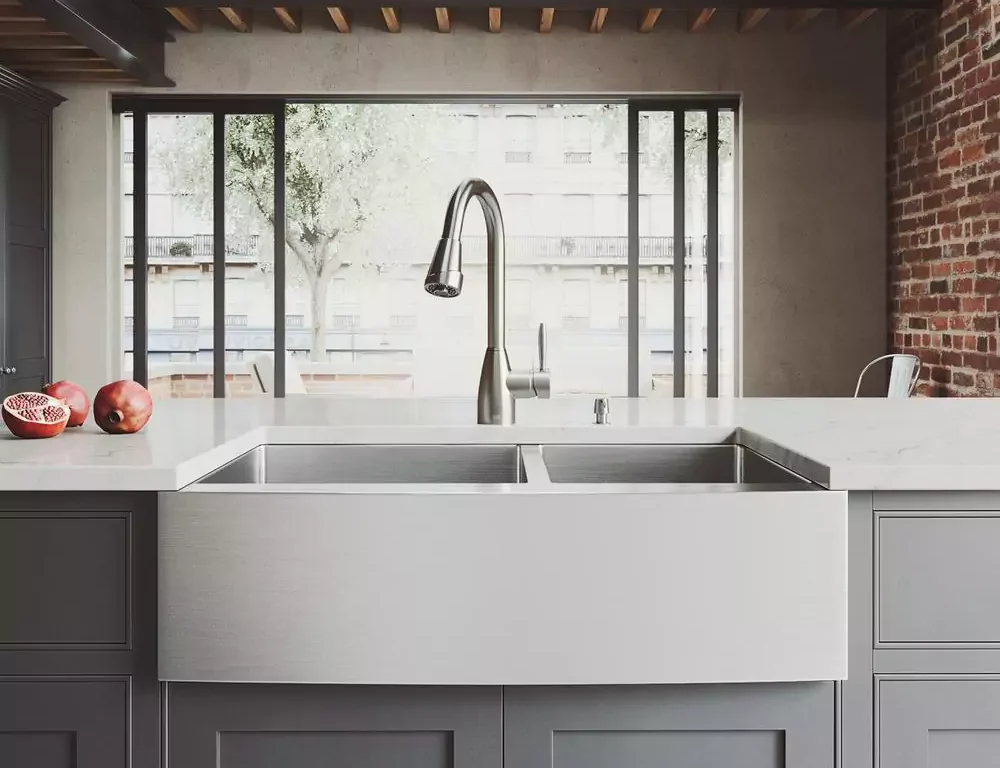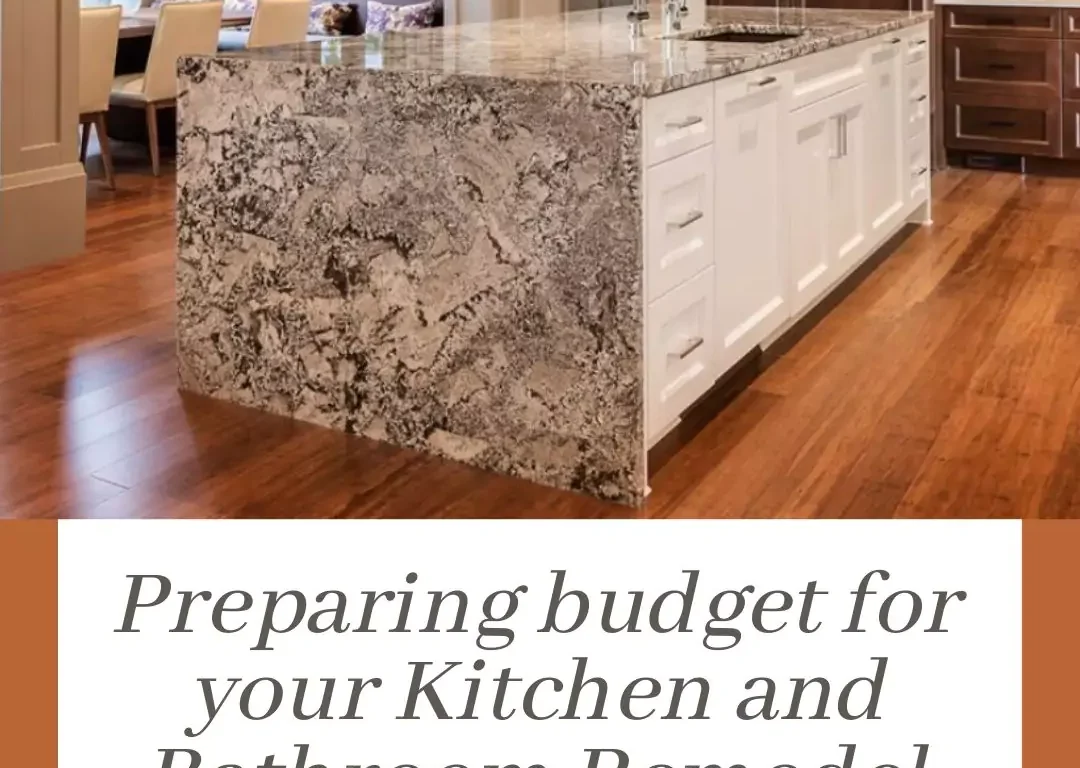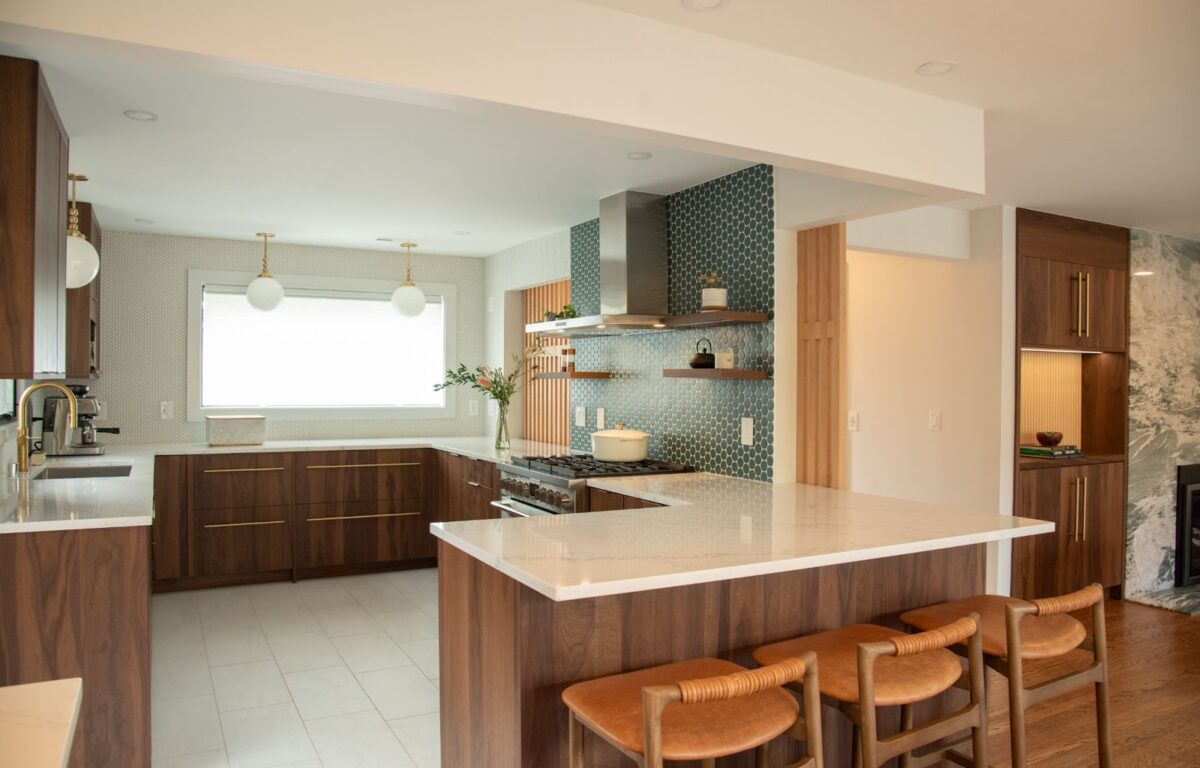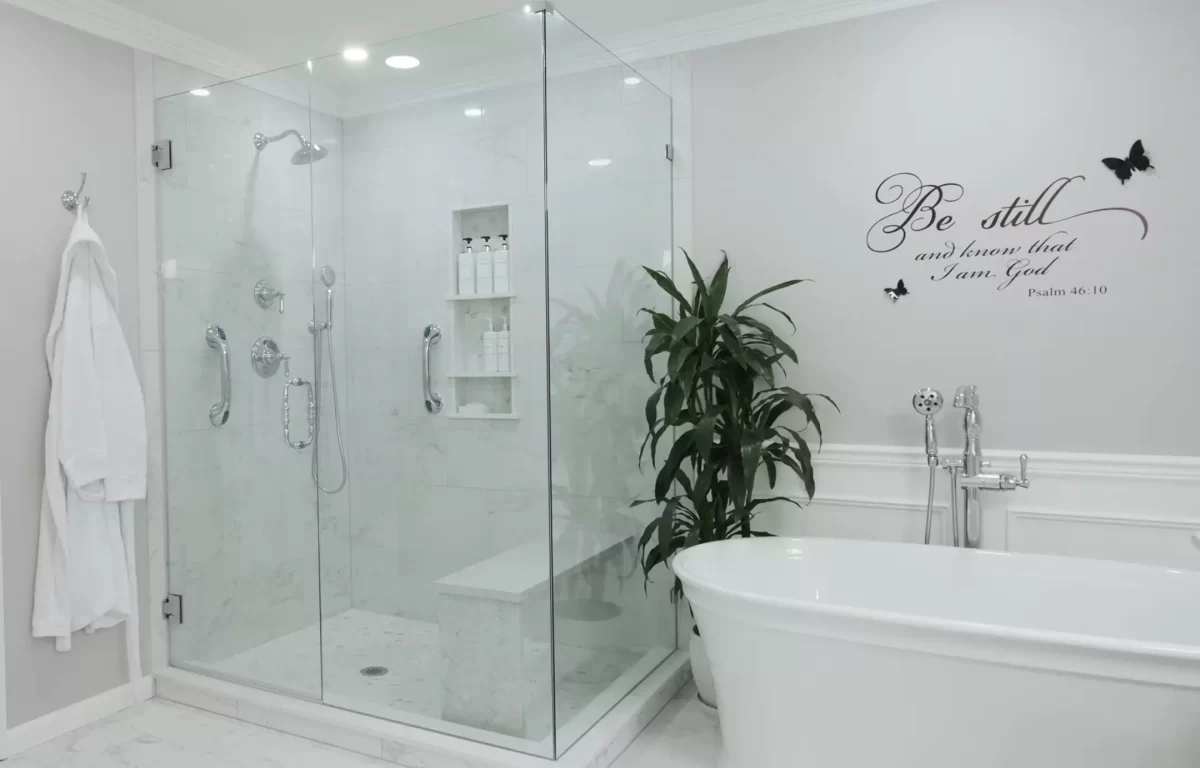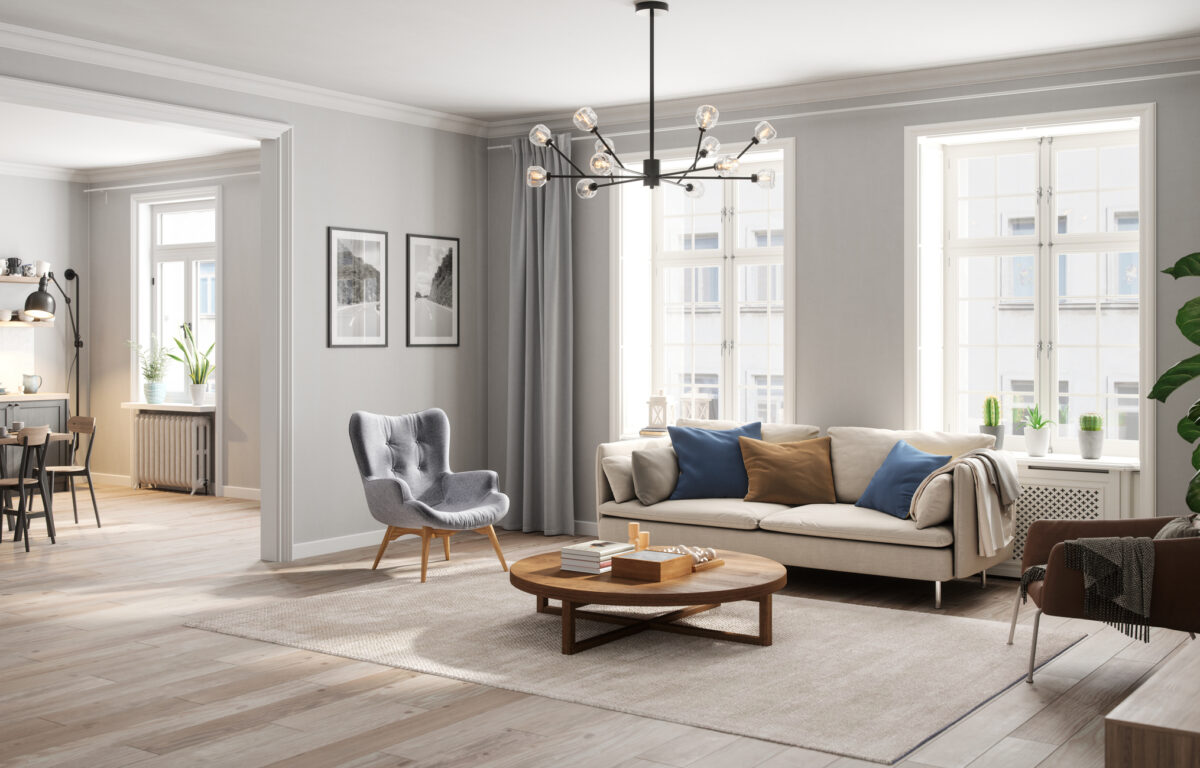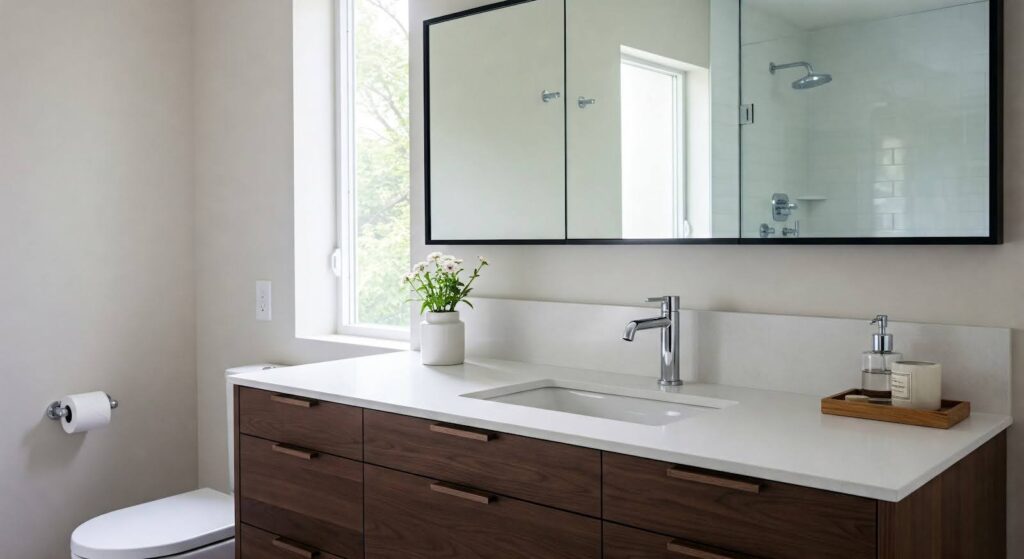
Water splashes near the sink, humidity from daily showers, and slow leaks under the vanity expose bathroom cabinetry to constant moisture. This exposure gradually leads to issues like warping, swelling, and surface deterioration. In many cases, water seeps into seams or unsealed edges, allowing mold to form behind panels or inside drawers.
Cabinets made from untreated or porous materials break down faster under these conditions. Consistent protection and maintenance help prevent this kind of damage. Kitchen & More helps homeowners address these risks with bathroom cabinetry and countertop solutions designed specifically for high-moisture environments.
In this blog, we’ll cover practical ways to safeguard your bathroom vanity using effective sealing methods, durable materials, and moisture-resistant design choices.
- Choose a Waterproof Vanity Material
Material selection determines how well a bathroom vanity resists long-term water exposure. Some materials naturally hold up better in humid, high-moisture environments, reducing the need for constant maintenance or repairs. As part of a complete bathroom renovation project, choosing the right vanity material is key to ensuring long-term performance and aesthetics:
- PVC (Polyvinyl Chloride): 100% waterproof, highly durable, and resistant to warping or swelling. Ideal for bathrooms with poor ventilation or heavy daily use.
- Marine-Grade Plywood: Engineered with water-resistant adhesives and multiple wood layers for added strength. Offers a good balance between durability and traditional appearance.
- Treated MDF (Medium-Density Fiberboard): Performs well when properly sealed, but should be used with caution in areas with standing water or poor drainage.
- Stainless Steel: Impervious to water and mold, extremely durable, and easy to clean. Best suited for modern or industrial-style bathrooms.
- Apply a Waterproof Sealant or Finish
Wood vanities are especially susceptible to water damage without the right protective coatings. Applying a waterproof sealant or finish creates a barrier that prevents moisture from soaking into the material and causing swelling, warping, or delamination over time. Use products specifically designed for high-moisture environments, like:
- Polyurethane: A clear, durable sealant that resists water and abrasion. Ideal for interior and exterior cabinet surfaces.
- Marine-Grade Varnish: Formulated for boats and docks, this finish provides superior resistance to prolonged water exposure.
- Water-Resistant Paints: Acrylic or enamel-based paints with mold inhibitors are effective for painted wood vanities.
Apply sealant to all exposed surfaces, including drawer edges, side panels, interior shelves, and especially the toe kick, where splashes and puddles tend to collect.
- Caulk All Gaps and Seams
Water intrusion often begins at transition points—where the vanity meets the wall, floor, or countertop. Apply a high-grade silicone caulk specifically rated for wet areas to seal seams along the backsplash, around sink openings, and at pipe penetrations in the cabinet base. These are common failure points that allow moisture to accumulate behind the vanity, leading to rot, mold, or substrate delamination.
Caulk must be applied to clean, dry surfaces and tooled properly to ensure adhesion. For wood vanities, sealing the bottom edges where water tends to pool is essential to maintaining structural integrity.
- Use a Waterproof Countertop
The countertop is the first line of defense against water infiltration. Selecting a non-porous, waterproof surface prevents water from seeping into seams and reaching the vanity base below. Materials like quartz, granite, and solid surface composites offer excellent moisture resistance when properly installed. Even bathroom countertops made of laminate can be effective, but only if the edges and seams are fully sealed to prevent swelling or peeling.
Avoid using unsealed wood or porous stone, as these materials absorb moisture quickly and are difficult to maintain in humid conditions. A well-installed, waterproof countertop helps preserve the cabinet structure from the top down. Kitchen & More offers high-performance porcelain countertops that are nonporous, heat-resistant, and stronger than granite—ideal for bathrooms where durability and moisture resistance matter most.
- Line the Inside of Cabinets
Adding a moisture barrier inside the vanity is a practical way to protect against leaks and spills. Use peel-and-stick vinyl tiles, waterproof shelf liners, or fitted plastic trays to cover the cabinet floor, especially beneath the sink. These materials prevent water from soaking into the substrate if a pipe drips or a bottle leaks. For vanities made of MDF or particleboard, interior lining significantly reduces the risk of swelling and delamination.
Planning interior protection at the cabinet level is often overlooked, yet it ranks among the most essential tips for planning a successful kitchen and bathroom remodel. This step is especially important in high-traffic bathrooms where products are frequently stored and moved.
- Control Humidity in the Bathroom
Humidity levels in the bathroom can damage vanities over time, even without direct water contact. Elevated moisture in the air causes wood and MDF components to expand, warp, or soften, especially in poorly ventilated spaces. Install a properly sized exhaust fan and run it during and after showers to reduce condensation buildup. In bathrooms without mechanical ventilation, crack a window to allow moisture to escape, or consider using a dehumidifier in enclosed spaces.
- Install a Splash Guard or Backsplash
Water commonly accumulates where the countertop meets the wall, especially in busy bathrooms or households with children. Installing a backsplash or integrated splash guard creates a physical barrier that stops water from seeping between the vanity and the wall.
For maximum protection, pair the backsplash with a continuous bead of silicone caulk along the seam to prevent moisture intrusion. This detail is especially important for vanities placed against drywall or in corner installations, where trapped water can lead to mold or material breakdown over time.
- Maintain Plumbing and Fixtures
Plumbing failures are a leading cause of hidden vanity damage. Dripping faucets, loose supply lines, and poorly sealed P-traps often go unnoticed until they’ve saturated the cabinet base. Schedule routine inspections to check for moisture under the sink, corrosion around fittings, or signs of mold on cabinet panels. Even a slow leak can compromise structural integrity over time.
For added protection, install under-sink trays or leak detectors that provide early warnings before damage spreads. Keeping plumbing components secure and watertight is essential for preserving the vanity and preventing costly repairs.
- Clean and Dry Surfaces Regularly
Routine maintenance plays a critical role in protecting bathroom vanities from moisture damage. Standing water around faucets, sink edges, or countertop seams gradually degrades finishes, especially on wood or painted surfaces. Encourage consistent habits like wiping down the vanity after each use, drying faucet bases, and cleaning up spills immediately. These simple actions prevent water from pooling along vulnerable edges where it can seep into joints or under surface coatings.
- Watch for Early Warning Signs
Water damage often starts subtly before becoming a major issue. Look for bubbling veneer, swollen cabinet panels, soft spots near the base, or musty odors—these are early indicators of moisture intrusion. Catching these signs early allows for targeted repairs, such as resealing or replacing hardware, before the entire vanity needs replacement. This approach is effective for both new installations and aging vanities that may already show signs of wear.
Protect Your Vanity With Kitchen & More
Protecting a bathroom vanity doesn’t require a full renovation—just a few smart upgrades and consistent maintenance. Small actions like sealing surfaces, managing humidity, and choosing water-resistant materials go a long way in preventing costly repairs. Prevention is always more cost-effective than cabinet replacement.
For those planning a remodel or new installation, Kitchen & More offers premium cabinetry built for durability in wet environments. We supply water-resistant cabinetry, sealed quartz countertops, and custom-fit bathroom vanities. Our team works closely with clients to ensure every element—from material selection to installation—is built to last in real-world conditions.
